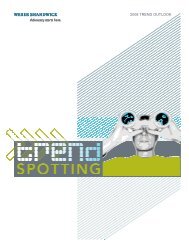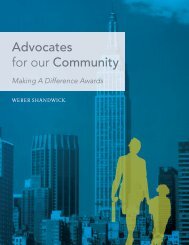White Paper - Weber Shandwick
White Paper - Weber Shandwick
White Paper - Weber Shandwick
Create successful ePaper yourself
Turn your PDF publications into a flip-book with our unique Google optimized e-Paper software.
How Content Fusion Works<br />
Content Fusion uses six key drivers to help an organization achieve its business objectives in this new<br />
environment: listening, stories, formats, vehicles, destinations and conversations. These drivers work<br />
toward establishing an organization as a publisher of its own “news” in a wide array of mediums and<br />
destinations, the end result being an increasing level of trust amongst its key audiences and the public.<br />
listening<br />
Any successful social media campaign begins with listening to<br />
the current conversations that surround your organization and its<br />
industry. Knowing what matters to your constituents and what kind<br />
of knowledge they are seeking is key to the Content Fusion framework.<br />
Listening informs an organization about which stories will<br />
best resonate and in which destination they will ring most true. A<br />
story told in the wrong place to the wrong audience is a waste of<br />
resources and may lead to other negative consequences.<br />
stories<br />
Every organization has unique stories. These stories come from<br />
within the heart of the organization: its people, events, knowledge,<br />
data, research, science, etc. Identifying these stories helps a company<br />
move toward becoming its own news outlet, producing<br />
content beyond what was once considered “news.” We’re not<br />
talking about corporate “fluff” or content for content’s sake. Nor<br />
are we talking about a high volume of stories, but rather a few,<br />
strategically distributed. We’re talking about real, meaningful,<br />
informative stories only that organization could create. Sometimes<br />
they are entertaining. Sometimes they are analytical, or insightful,<br />
or research-driven … hopefully it’s some combination of all of<br />
these and more.<br />
Consider the example of a hypothetical corporate scientist in<br />
Argentina researching plants in search of an enzyme to develop<br />
a more eco-friendly plastic. Her knowledge and experience are<br />
unique to herself and her company, and can be shared as a story<br />
– widely. Her story has potential relevance to people interested<br />
in science, biology, travel, engineering and green initiatives. The<br />
ecosystem for this one story is vast.<br />
formats<br />
Our scientist’s story can also be told in a variety of formats to<br />
achieve the greatest level of interest and sharing – text, photo,<br />
image, video, audio. (Remember: we now watch our newspapers.)<br />
Our scientist can take photos and videos from the field, through<br />
which she can show, not just tell, her developing story. Graphic<br />
artists can take her data and produce infographics to be shared<br />
across the Internet. To be absorbed and shared, the story must live<br />
beyond the written word alone.<br />
6





